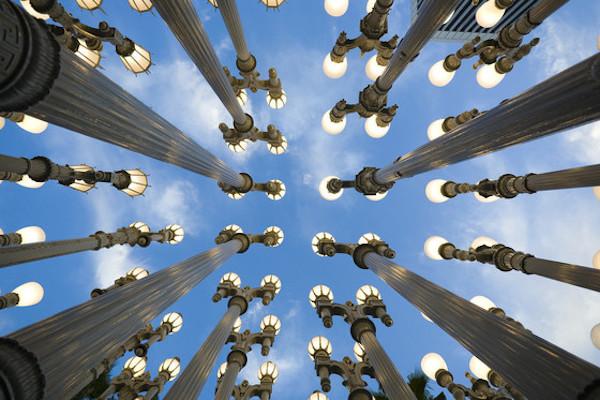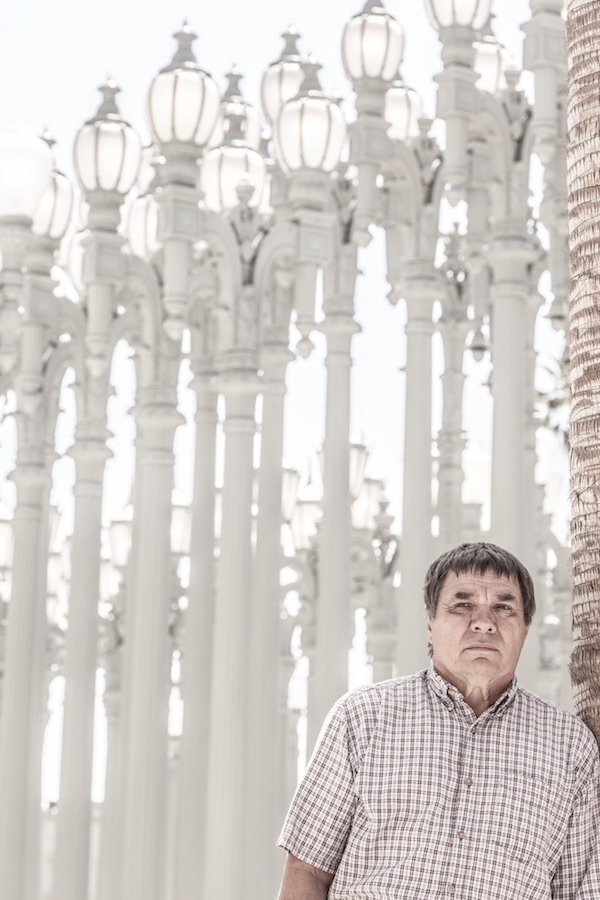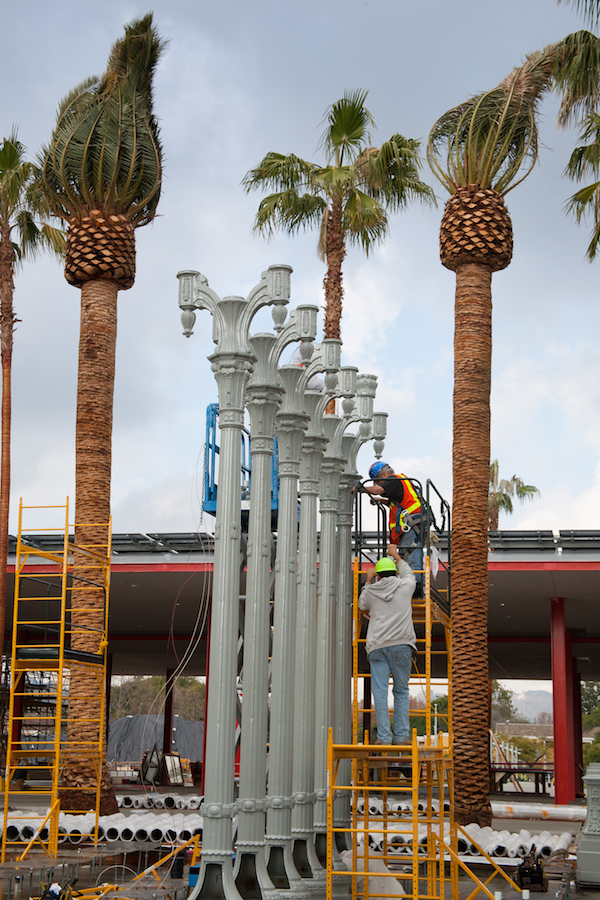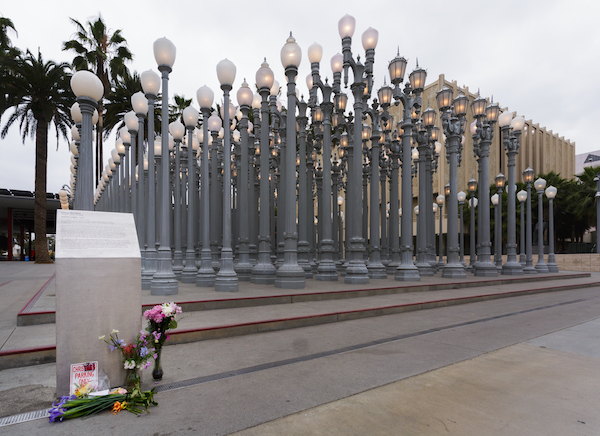This week marks Urban Light’s 10th anniversary. Since its opening at LACMA in February 2008, Urban Light has been unofficially adopted by Los Angeles as a symbol of the city and is indisputably the most popular artwork on campus. Composed of 202 historic streetlamps dating from the 1920s and 1930s originally spread throughout Southern California, the large-scale sculpture, the Gordon Family Foundation’s gift to Transformation: The LACMA Campaign, has become ubiquitous as the face of LACMA, a point of pride for many Angelenos, and a destination for visitors from around the world. In honor of the sculpture's 10th anniversary, the Leonardo DiCaprio Foundation has generously supported the replacement of all 309 incandescent light bulbs with LED bulbs, resulting in approximately 90% in power savings for LACMA while also reducing emissions of greenhouse gas and other harmful pollutants.
Urban Light is one of several works by Chris Burden (1946–2015) in LACMA’s collection. Burden, who was born in Boston, Massachusetts, moved to California in 1965. During the early 1970s, Burden’s first mature works were characterized by the idea that the truly important, viable art of the future would not be objects, but that art would be ephemeral and address political, social, environmental, and technological change. The images of Burden that continue to resonate in the public mind are of the artist who had himself shot (Shoot, 1971), locked up (Five Day Locker PIece, 1971), electrocuted (Doorway to Heaven, 1973), cut (Through the Night Softly, 1973), crucified (Trans-fixed, 1974), and advertised on television (4 TV Ads, 1937–77). His work subsequently shifted, focusing on monumental sculptures and large-scale installations, two of which—Urban Light (2008), and Metropolis II (2010)—are currently on view at LACMA.
In honor of Urban Light, we are sharing an excerpt of a public conversation about the sculpture between LACMA CEO and Wallis Annenberg Director Michael Govan and Burden, hosted at LACMA in December 2008.
Govan: Let’s talk about the making of Urban Light.
Burden: Well, this wasn’t something I planned to do. One day I was walking around at the Rose Bowl Flea Market with my friend Paul Schimmel and his son, Max, and Max came running over and said, “Oh, you should check these out, Chris.” I went over and I saw two of these antique lamps spread in parts. The man who was selling them, Jeff Levine, said, “Oh yeah, they’re genuine. They’re from the ’20s. You can buy them both. I’ll give you a real good price and I’ll deliver them.” So he brought them out and I said, “Do you have any more?” He said, “Yeah, I got four more like that.” I said, “Well, okay, I’ll buy those too.” Over the course of a year I bought about 70 that he had in his backyard, all in this state of component parts. I lugged them all up to my place in Topanga. But he was saving some of the really big ones and he didn’t want to sell to me. So I asked him, “Do other people collect these lamps too?”
.jpg)
Jeff had been collecting them for about 20 years, and he would go to the city when they were knocking them down. The city didn’t really care about them—most of them got taken to the landfill and thrown away—but he would go through all the broken parts. If there were 20 busted-up lamps he could salvage enough parts to make, maybe, three lamps. And he single-handedly moved all the stuff around. He’d gotten tired of being their caretaker. So when I asked him if other people collected them, because I wanted to buy more, he confessed he had another 85 stored.
We went through the whole process of having them sandblasted, powder-coated, replacing all the hardware with stainless steel or copper. Jeff loved these lamps, so when he said to me, “I knew you would come someday,” I took that as a compliment, because he had made this huge collection and he really didn’t want to sell them off in twos or threes to homeowners to have in their driveways. He was hoping that somebody would show up to keep his collection intact, and I was the guy. Through him I met a small group of lamp aficionados, who’ve all known each other for 20 or 30 years, and swap parts.
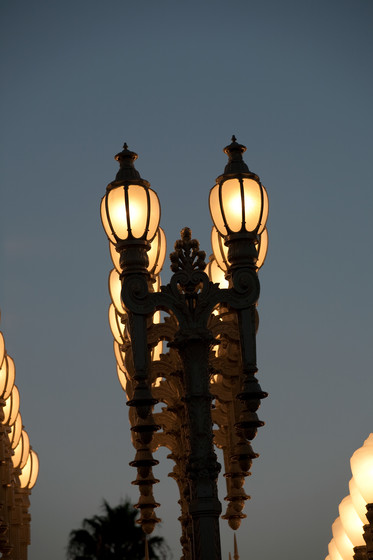
One of the most beautiful lamps is called the Broadway Rose. There’s an artichoke in the finial, and also rosebuds. These lamps have a very interesting history. Their finials are very, very long, and for the first several years they were installed downtown. There are six of them in Urban Light and 11 of them left in Los Angeles. The reason for the long finials was that they predated the filament, the incandescent light bulb. They were carbon arc lights; a carbon arc has two carbon rods that are spaced slightly apart. You add a high voltage and there’s a huge spark. So the wick trimmer had to come every two or three days and crank the rod up to keep the right gap. So when you see streetlights with finials, those are all vestiges of a functioning finial, which initially these were.
Govan: I remember being incredibly amazed by them and knowing that they had to be in Los Angeles, because, in so many ways, they were the representation of the whole county, with each city responsible for designing its own lamps. Each lamp, then, was an expression of that city’s design; they were public art. And, of course, they’ve now created this image through their density. You always knew they needed to be densely arranged, right?
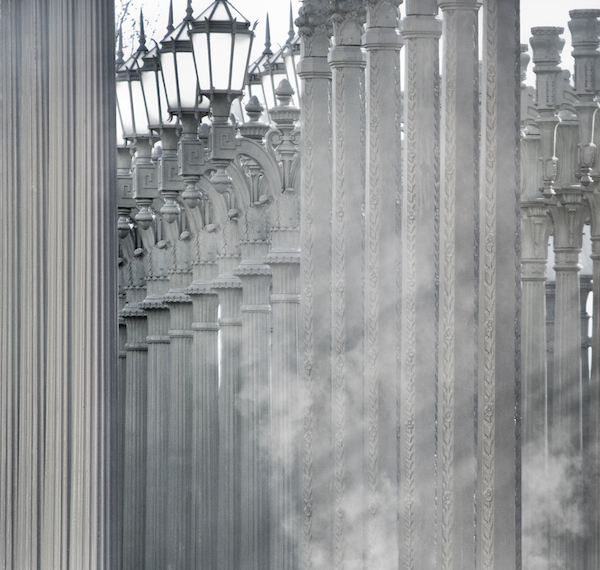
Burden: Yeah, and you needed a repetition of form, too. It’s kind of like lining up toy soldiers—you know, where you get little columns of them. And I think the repetition works.
Govan: When we looked at this space in front of the museum, it was an instant eureka moment, because these lamps had been assembled into architecture; they have this feeling of a Roman colonnade or some kind of ancient structure. While they’re from the ’20s and they’re modern, they still give this feeling of walking through an ancient temple. And immediately it seemed to me this was the perfect image for a museum in Los Angeles, because all of those East Coast museums, even as far west as Chicago, have their Greco-Roman temple façades; that’s the sign that you’re walking into a museum—you see the temple façade. But, of course, this is a kind of faux temple. It’s an interesting reversal because those Greco-Roman temple façades on East Coast museums are really faux; they’re neoclassical. And here you’ve assembled an honest-to-goodness Los Angeles temple made of local materials, in our time.
Now Urban Light has become this incredible landmark in Los Angeles. People are out there every day taking photos of it. And in this new age of media and technology, these images of the lamps are going out all over the world and representing Los Angeles. You’ll see people getting out of their cars to capture it, lovers taking pictures under the lamps at night. People have been fascinated by the details.
Chris, you said that you saw the lamps as a statement about what constitutes a sophisticated society—“safe after dark and beautiful to behold”—which I thought was an incredible statement. And I started thinking about that in relation to the history of all your work. People have written so much about your early performances. They’ve even called them “cold and without morality,” for instance, in response to having yourself shot for Shoot. But I actually had the exact opposite reading, that somehow all of your work has something to do with a sense of responsibility. Whether it’s you, as an artist, investigating those phenomena or thinking about the urban environment, there is some sense of what societal responsibility is. It seems to me that maybe your work has this arc that has held it all together. Do you feel that there is something beneath all of this that you can put your own finger on?
Burden: Well, I often think it’s about imagining something, something you might reject as being out of hand, initially, and then trying to look at the other side of the coin and seeing what that might be. I think there are often two ways to look at something.
Urban Light is turned on each day at dusk and turned off at dawn, according to an astronomical timer. The installation is always open for visitors. All images of Urban Light © Chris Burden/licensed by The Chris Burden Estate and Artists Rights Society (ARS), New York.



